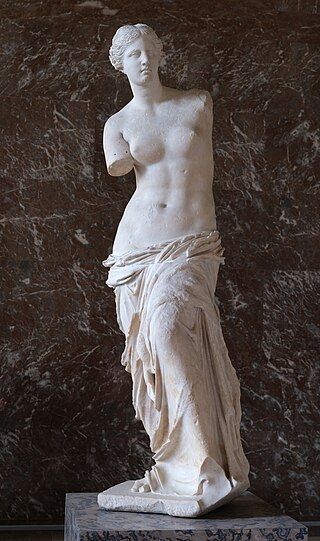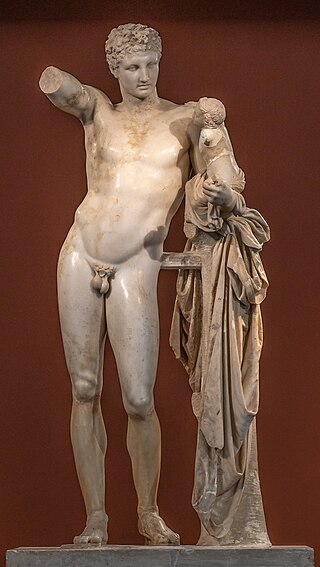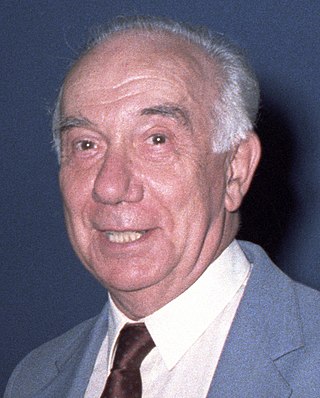Related Research Articles

The Louvre, or the Louvre Museum, is a national art museum in Paris, France, and one of the most famous museums in the world. It is located on the Right Bank of the Seine in the city's 1st arrondissement and home to some of the most canonical works of Western art, including the Mona Lisa,Venus de Milo, and Winged Victory. The museum is housed in the Louvre Palace, originally built in the late 12th to 13th century under Philip II. Remnants of the Medieval Louvre fortress are visible in the basement of the museum. Due to urban expansion, the fortress eventually lost its defensive function, and in 1546 Francis I converted it into the primary residence of the French kings.

The Venus de Milo or Aphrodite of Melos is an ancient Greek marble sculpture that was created during the Hellenistic period. Its exact dating is uncertain, but the modern consensus places it in the 2nd century BC, perhaps between 160 and 110 BC. It was rediscovered in 1820 on the island of Milos, Greece, and has been displayed at the Louvre Museum since 1821. Since the statue's discovery, it has become one of the most famous works of ancient Greek sculpture in the world.

Praxiteles of Athens, the son of Cephisodotus the Elder, was the most renowned of the Attic sculptors of the 4th century BC. He was the first to sculpt the nude female form in a life-size statue. While no indubitably attributable sculpture by Praxiteles is extant, numerous copies of his works have survived; several authors, including Pliny the Elder, wrote of his works; and coins engraved with silhouettes of his various famous statuary types from the period still exist.
Edmond François Paul Pottier was an art historian and archaeologist who was instrumental in establishing the Corpus vasorum antiquorum. He was a pioneering scholar in the study of Ancient Greek pottery.
Michel Laclotte was a French art historian and museum director, specialising in 14th and 15th century Italian and French painting.

Hermes and the Infant Dionysus, also known as the Hermes of Praxiteles or the Hermes of Olympia is an ancient Greek sculpture of Hermes and the infant Dionysus discovered in 1877 in the ruins of the Temple of Hera, Olympia, in Greece. It is displayed at the Archaeological Museum of Olympia.
Christiane Ziegler, is a French Egyptologist, curator, director emeritus of the Department of Egyptian Antiquities of the Louvre Museum and editorial director of the archaeological mission from the Louvre Museum at Saqqara, Egypt.
Laurence Bertrand Dorléac is a French art historian specializing in contemporary art, a professor and an author. She was elected president of the Fondation nationale des sciences politiques in May 2021. She is located in Boulogne-Billancourt, France.

The Dancers of Delphi, also known as the Acanthus Column, are three figures in high relief on top of an acanthus column found near the sanctuary of Pythian Apollo at Delphi. They are on display in the Delphi Archaeological Museum and were the inspiration for the first of Claude Debussy's Préludes.
Jean-Luc Martinez, born on March 22, 1964, is a French archaeologist and art historian specializing in ancient Greek sculpture. Currently serving as a thematic ambassador responsible for international cooperation in the field of heritage, he was previously the president-director of the Louvre Museum from 2013 to 2021.

Léon-Maxime Collignon was a French archaeologist who specialized in ancient Greek art and architecture.
Jean Marie Augustin Charbonneaux was a 20th-century French archaeologist.

Jean Marcadé was a French hellenist historian. He was a member of the Institut de France.
Pierre Devambez was a 20th-century French Hellenist, archaeologist and historian of Greek art.
Étienne-Louis-Charles-Alexandre Michon was a French art historian.
Paul Frédéric Girard was a French Hellenist, archaeologist and epigrapher.
Michel Labrousse was a 20th-century French historian.
Dominique Briquel is a French scholar, a specialist of archaeology and etruscology. Briquel studied at the École Normale Supérieure from 1964 to 1969 and was a member of the École française de Rome from 1971 to 1974. Since 1974 he taught Latin at the École Normale Supérieure. From 1984 to 1996 he was a professor of Latin at the University of Burgundy in Dijon. Since 1992, he has been Director of studies at the École pratique des hautes études, in the department of historical and philological sciences and since 1996, professor of Latin at the Université de Paris-Sorbonne.

Alain Erlande-Brandenburg was a French art historian and honorary general curator for heritage, a specialist on Gothic and Romanesque art.
The Grand Louvre refers to the decade-long project initiated by French President François Mitterrand in 1981 of expanding and remodeling the Louvre – both the building and the museum – by moving the French Finance Ministry, which had been located in the Louvre's northern wing since 1871, to a different location. The centerpiece of the Grand Louvre is the Louvre Pyramid designed by Chinese-American architect I. M. Pei, which was also the project's most controversial component. The Grand Louvre was substantially completed in the late 1990s, even though its last elements were only finalized in the 2010s.
References
- ↑ "Praxiteles". Louvre museum. Archived from the original on June 15, 2011. Retrieved June 14, 2010.